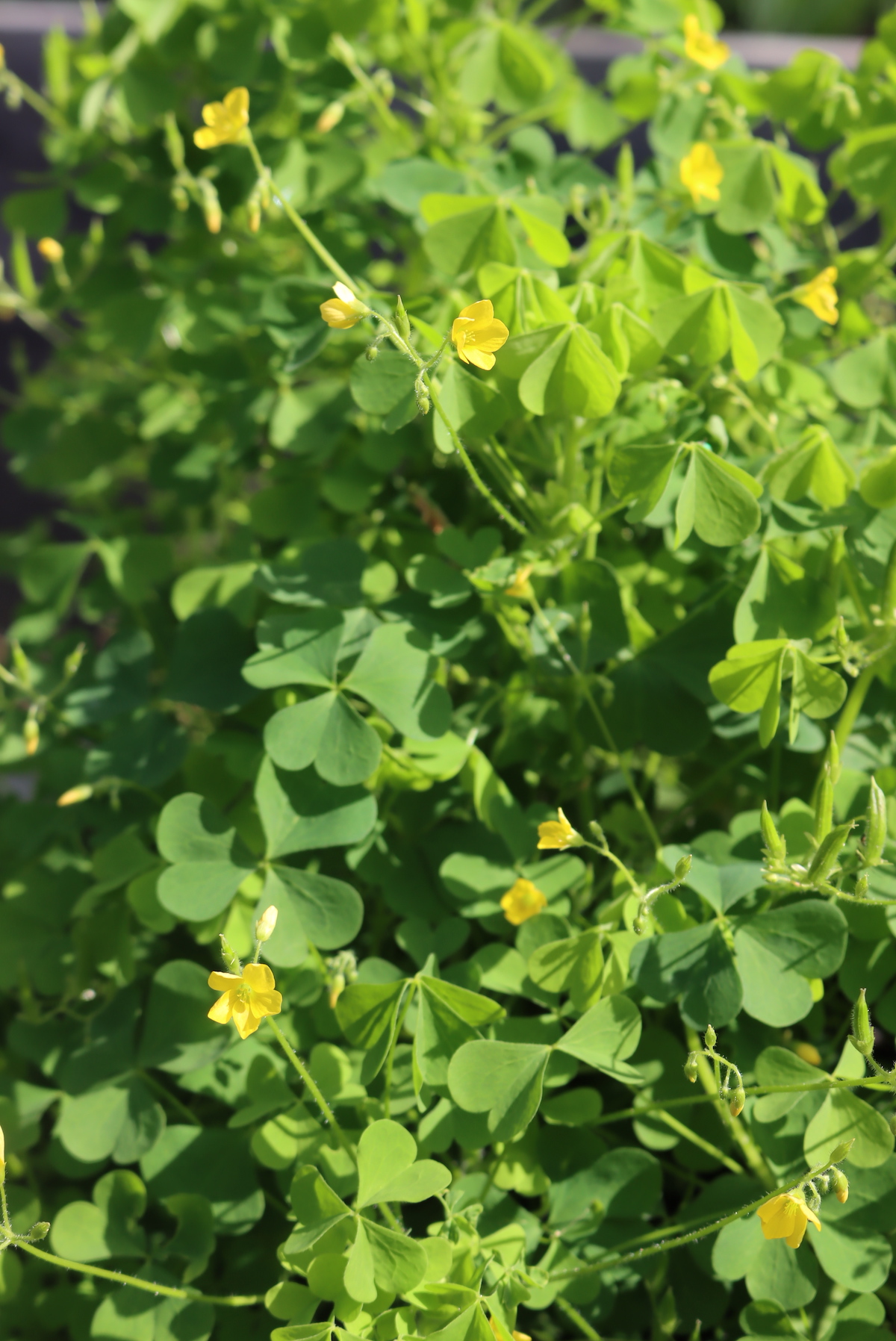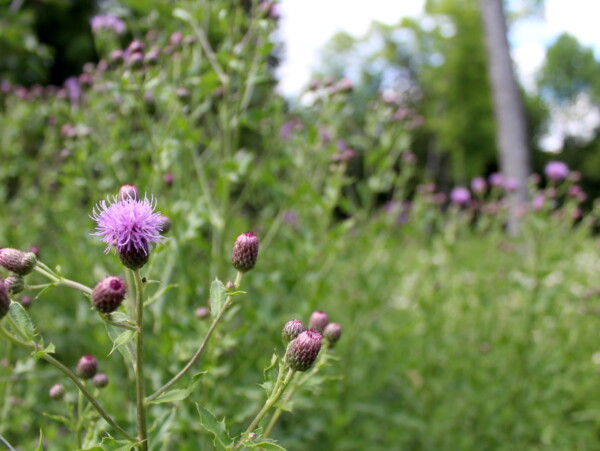Affiliate disclosure: This post may contain affiliate links. Please see our Privacy Policy.
Wood Sorrel (Oxalis sp.) is a delicious edible wild weed with a bright, lemony flavor. It grows all over the world, and it’s easy to identify.

Wood sorrel is one of the most uniquely flavored wild weeds anywhere, and instead of tasting like a “green” it tastes like a mix between cucumber and lemon.
The leaves are ever so slightly sour, but it’s just a hint. My pre-schoolers absolutely love popping wood sorrel leaves into their mouths right out in the garden, where it’s a common weed all summer long.
It’s unique flavor means it can be used in all manner of ways, from savory to sweet. Wood sorrel sorbet is absolutely amazing, and you’d never guess it comes from a wild edible weed (instead of a fruit).
(There are many species of wood sorrel, but they all share many of the same characteristics. All of the wood sorrel pictures in this article are Common Yellow Wood Sorrel (Oxalis stricta), which is one of the most common species. If you’d like to try growing wood sorrel, you can also buy Wood Sorrel Seed Packets to plant in your garden. It’s easy to grow and delicious.)

What is Wood Sorrel?
Oxalis is a genus comprised of over 550 species of flowering plants found worldwide.
Many of these species are known as wood sorrels, but they have other common names, including yellow sorrels, yellow oxalis, pink sorrels, shamrock, false shamrocks, sour grasses, sleeping beauty, sour trefoil, sheep’s clover, and oxalises.
Depending on the species, this herbaceous weed may be perennial or annual. One of the most common species in North America is the native, perennial Common Yellow Wood Sorrel. There are also many cultivated varieties available today.
Is Wood Sorrel Edible?
The entire Wood Sorrel plant is edible. People have consumed different varieties of wood sorrel worldwide for hundreds of years. As the common name sour grass suggests, it’s known for its sour flavor, due to the plant’s oxalic acid content.
Wood Sorrel should be eaten in moderation. While oxalic acid isn’t poisonous, excessive amounts can prevent your body from absorbing essential nutrients and minerals. It may also cause kidney stones.
Don’t use Wood Sorrel from areas that may have been polluted or sprayed with chemicals like pesticides.
Wood Sorrel Medicinal Benefits
Wood Sorrel has a long history of use in herbal medicine. Worldwide, herbalists have used species of Wood Sorrel to treat various ailments, including cancer, scurvy, indigestion, liver problems, digestive disorders, nausea, fever, mouth irritations, and swelling.
Today in North America, it is primarily used as an edible herb rather than a medicinal one. However, some modern studies have indicated that Wood Sorrel has some promising medicinal properties and should be studied further.
One study found that Creeping Wood Sorrel (Oxalis corniculata) leaves contain various medicinal substances and possess some medicinal properties, including antioxidant, anti-inflammatory, antimicrobial, astringent, diuretic, febrifuge, and cardio-relaxant.
Another study found that Common Yellow Wood Sorrel (Oxalis stricta) has considerable antioxidant properties and supports the plant’s use in certain medicinal preparations, including treating fevers, loss of appetite, stomach cramps, external inflammation, and more.
Wood Sorrel can be employed internally by creating an infusion with the entire plant or externally by making a poultice.
Where to Find Wood Sorrel
Different species of Wood Sorrel may be found worldwide except in polar regions. It will grow in various habitats, including gardens, lawns, vacant lots, waste areas, open woodlands, roadsides, and other disturbed areas.
Wood Sorrel prefers partial shade and moist soil but will tolerate a wide range of conditions. Wood Sorrel may grow in the shade to full sun and may grow in fertile or poor soil.
Some species are in cultivation. False Shamrock (Oxalis triangularis) is commonly kept as a houseplant. Oca or Uqa (Oxalis tuberosa) is not known in the wild but is cultivated in the Andes and New Zealand.
When to Find Wood Sorrel
In tropical climates, it’s often possible to find Wood Sorrel year-round. In the United States, it’s possible to forage for Wood Sorrel roughly from spring to fall. You may find it in early spring in warmer areas like the deep south, but it may not appear until early summer in northern regions.
Identifying Wood Sorrel
Wood Sorrel is an herbaceous weed with a rather dainty appearance. As the common name false shamrock suggests, it bares some resemblance to a shamrock.
It’s often found in patches or clumps. Oxalis may reproduce and spread in multiple ways, including seeds, stolons, rhizomes, or bulbils, depending on the species. Certain species, like Creeping Wood Sorrel (O. corniculata) form low, dense mats while others have a more upright appearance.
All of the wood sorrel pictures in this article are Common Yellow Wood Sorrel (Oxalis stricta).

Wood Sorrel Leaves
Wood Sorrels have palmately compound leaves. Most Wood Sorrels have leaves that are made up of three to four leaflets, but some may have up to ten leaflets.
The leaflets are heart-shaped with a crease along the middle, allowing them to fold at night and during storms. They are often green but may be purple or burgundy or have markings of those colors.
For example, the species False Shamrock (Oxalis triangularis) is usually purple.

Wood Sorrel Stems
Wood Sorrel stems are relatively thin and delicate. They’re typically light green but may be reddish in some species. They are usually smooth or slightly hairy. The stem height varies with species, but most are herbaceous weeds and stay fairly small.
Wood Sorrel Flowers
The bloom period for Wood Sorrels varies widely over their range. In North America, they typically bloom between spring and fall but may bloom year-round in warm climates.
Wood Sorrel flowers typically have five petals that are fused at the base. They also usually have ten stamens. The flowers vary in color depending on the species and may be yellow, white, violet, red, or pink.

Wood Sorrel Roots
Some species of wood sorrel have fleshy, tuberous roots. This is especially true of Oca or Uqa (Oxalis tuberosa), which is cultivated for its large edible tubers. These tubers look a bit like potatoes and may be yellowish, pink, or purple.
Wood Sorrel Seeds
Wood Sorrel seeds resemble tiny, green okra pods. Usually, they grow upright and are less than one inch long. When the seed pods are ripe, they “explode” and shoot their seeds into the air.
Wood Sorrel Look-Alikes
Wood Sorrel is sometimes confused with various clover species, including white clover (Trifolium repens), red clover (Trifolium pratense), and crimson clover (Trifolium incarnatum). However, all clovers can be differentiated from all Wood Sorrel species in several easy-to-spot ways:
- Clover leaflets are round instead of heart-shaped.
- Clover leaflets lack a center crease and don’t fold in half.
- Clovers don’t produce okra-like seed pods.
- Clovers produce round or long inflorescences with a spiky appearance rather than single flowers.

Ways to Use Wood Sorrel
You can employ this beautiful plant in various ways in the kitchen, either raw or cooked. The entire plant can is edible. Try adding Wood Sorrel leaves, stems, and blooms to green salads, potato salads, rice dishes, soups, teas, and cold drinks. The leaves are sometimes used in India to create a sour fish curry.
You can also use the tubers of certain varieties cooked as you would potatoes or sweet potatoes or raw like other root vegetables. Oca or Uqa (Oxalis tuberosa) can be cultivated for this purpose. Raw, it has a crunchy, carrot-like texture, but cooked, it’s softer and starchy. In Mexico, it’s often eaten raw with salt, lemon, and hot pepper.
While not commonly used in the United States, you can also use Wood Sorrel as a medicinal herb. Wood Sorrel can be used externally as a poultice to treat minor inflammation. For internal use, use Wood Sorrel in teas and other infusions.
In addition, various Wood Sorrels species are cultivated for ornamental purposes, and fiber artists employ certain Wood Sorrels to create yellow or orange dyes.
Wood Sorrel Recipes
Wood Sorrel is an excellent choice for refreshing summer recipes.
- Try this chilled, lemony wood sorrel soup from Very Vegan Val.
Wood Sorrel’s lemony flavor lends it to easy use in desserts too.
- Try this Wood Sorrel sorbet to get even picky eaters excited about foraging.
- Or these Wood Sorrel mini cream tarts with this fun recipe from Gather Victoria
Cocktails and cool summer drinks can also be an exciting way to use some of your wood sorrels.
- Try this recipe for Wood Sorrel Gimlet and simple syrup from Escarpment Kombucha.
- Learn to make Wood Sorrel “lemonade” and herbal tea with this simple guide from Alt Nature.
Summer Foraging Guides
Looking for more edible wild plants to forage this summer?
- Foraging Fireweed (Rosebay Willowherb)
- Foraging Yarrow
- Foraging Saskatoons (Serviceberries)
- Foraging Wild Black Cherries
- Foraging Chokecherries





Love Wood Sorrel, probably one of my favourite garnishes. Looks so pretty on the plate!
My mom used to put sugar and milk (probably coffee cream really) on a little serving of O. whichever for us every spring. I think I remember it growing between the porch steps or maybe near their foot, very shaded. Leaves smallish, very thin, not a trace of a hair.